

Cuban Aviators, II PartAntonio Menéndez Peláez, Augustín Parlá, Rafael Del Pino DiazRuben Urribarres |
Captain, made the first alone flight Havana-Madrid, and the flight "For the Columbus Lighthouse"
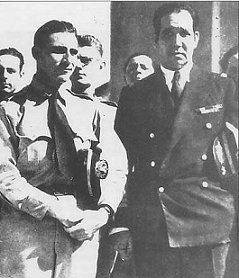 At the left, Menéndez Peláez, besides the Colonel
González, the Cuban Constitutional Navy Chief
At the left, Menéndez Peláez, besides the Colonel
González, the Cuban Constitutional Navy Chief
He was born in 1902 in Santa Eulalia de Riveras, Asturias, Spain. Menéndez Peláez was naturalizated Cuban, and become captain of the Cuban Naval Aviation. He was the first Cuban in reaching the heroical flight over the Atlantic Ocean, flying since Havana to Sevilla, Spain, in solitary, in an one motor aircraft with open cockpit. This was an Lockheed "Sirius" of wood lined, and that have one Pratt & Whitney WASP motor, of 550 HP, 180mph cruiser velocity and without radio, baptized with the name of "4 of setiembre" (the Batista's sergeants revolution). This flight was maded in homage to the spanish aviators Barberan and Collar, that made the flight Sevilla-Camaguey in 1933, and that after this, they disappeared after take off from Havana to Mexico.
Menendez Pelaez comes take off from Havana in January 10, 1936, and from the military stip of Camaguey in January 13. Later doing scales in Venezuela, Natal and Dakar. He lands at February 17, 1936 in the spanish airstrip Tablada, Sevilla, where was received for high spanish authorities. In total he flew 11,200 km, in 9 phases, and employment for it 33 days, 10 hours and 20 minutes, a total flight time of 61 hours, in a 115 miles per hour in average. With this he becomes the first Hispanic aviator in flying from America to Europe.
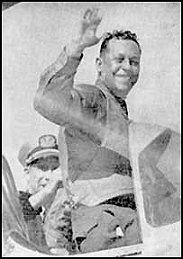 In
November 11, 1937 Menéndez Peláez began the flight organizated by
the Panamerican Columbist Society "For the Columbus Lighthouse" (participate three
Cuban airplanes," Nina", "Pinta" and "Santa Maria" and one Dominican, the "Colon"),
with 53 planificied phases. Menéndez Peláez piloted the "Santa Maria",
in company of the mechanical Manuel Naranjo and Ruy de Lugo Vinas, official columnist
of the flight. In December 29, 1937, few minutes after the Escuadrilla Panamericana
take off from the airstrip of Cali, Colombia, they suffered a frightening accident,
when the three Cuban airplanes being precipitated to ground, wrapped in flames.
Antonio Menéndez Peláez dying in the aiplane 'Santa Maria', and
died too its six others Cuban comrades in the other two airplanes. They perished
when crashed to a hill, little time after take off.
In
November 11, 1937 Menéndez Peláez began the flight organizated by
the Panamerican Columbist Society "For the Columbus Lighthouse" (participate three
Cuban airplanes," Nina", "Pinta" and "Santa Maria" and one Dominican, the "Colon"),
with 53 planificied phases. Menéndez Peláez piloted the "Santa Maria",
in company of the mechanical Manuel Naranjo and Ruy de Lugo Vinas, official columnist
of the flight. In December 29, 1937, few minutes after the Escuadrilla Panamericana
take off from the airstrip of Cali, Colombia, they suffered a frightening accident,
when the three Cuban airplanes being precipitated to ground, wrapped in flames.
Antonio Menéndez Peláez dying in the aiplane 'Santa Maria', and
died too its six others Cuban comrades in the other two airplanes. They perished
when crashed to a hill, little time after take off.
The chroniques count:
"The arrival of their remainders to Cuba constitute an impressive national act
of sorrow. To their funeral responded the then president of the Republica, high
officials of the State and the Government, and representatives of the diplomatic
corp accredited in Cuba. Her body and that of their expedition comrades were exposed
in the Salon of the Steps Lost of the National Capitoly, and they were yielded
by high military honors to do subsequently burial in the Armed Forces Panteon
of the Colon Cemetery. By their heroically activities, Menéndez Peláez
take the same high condecorations of Cuba and Spain, their natal ground. He was
married with a Cuban of Cumanayagua, Ofelia Garcia Brugueras (1920-1984), at the
April 3, 1937, and they had a son, Antonio Menendez Garcia.
![]() Agustín Parlá Orduña
Agustín Parlá Orduña
Cuban
Aviation Pioneer, and First Cuban Pilot
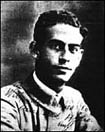 He
was born in October 10, 1887. Her parents emigrated to Key West during the war
with Spain of 1895-1898. The father was friend of Jose Marti, job and sought money
for the Cuban revolution. Parlá born and grow in Key West, and after the
war the family return to Havana. In 1911 he travels to the Curtiss school in Hammondsport
to learn to fly. In January 2, 1912 Parlá becomes the first Cuban
to flying in a airplane, when the American pilot Charles F. Walshen
mount it in its airplane over Havana. In March of 1912 he made her first alone
flight in Miami. In April 20, 1912 he obtains the pilot license when graduating
in the Curtiss School of Aviation of Miami, Florida, being in this manner the
first Cuban graduated pilot.
He
was born in October 10, 1887. Her parents emigrated to Key West during the war
with Spain of 1895-1898. The father was friend of Jose Marti, job and sought money
for the Cuban revolution. Parlá born and grow in Key West, and after the
war the family return to Havana. In 1911 he travels to the Curtiss school in Hammondsport
to learn to fly. In January 2, 1912 Parlá becomes the first Cuban
to flying in a airplane, when the American pilot Charles F. Walshen
mount it in its airplane over Havana. In March of 1912 he made her first alone
flight in Miami. In April 20, 1912 he obtains the pilot license when graduating
in the Curtiss School of Aviation of Miami, Florida, being in this manner the
first Cuban graduated pilot. May 19, 1913 Agustín Parlá made the feat that it made famous, when crossing the strait of the Florida flying from Key West to Mariel, in an airplane without instruments. The spanish aviator Domingo Rosillo competed with Parlá and arrive first, but Rosillo prefered to fly with the company of ships. Parlá fly alone in this Flight of audacious, with the flag that Jose Marti carried for the Florida, when he collect money for the revolution. The flight went of 160 km, with a time of 2h.55m, and Parla receives $5,000 as prize by the second place.
In July
5, 1913, when is created the Cuban Army Air Corp, Agustín Parlá
is named Captain, as "Father of the Cuban Aviation". Its airplane is acquired
as the second military apparatus of the country. In August of 1913 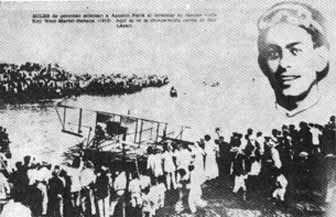 Parlá
is named Leader of Instructors of the Air Corp. The September 24, 1916, in Buffalo,
NY, he flies over the Niagara, gaining a international competition. In her honor
was hoisted the Cuban flag and play the national hymn. The famous Cuban composer
Antonio M.Romeu composed the song "Parlá over the Niagara".
Parlá
is named Leader of Instructors of the Air Corp. The September 24, 1916, in Buffalo,
NY, he flies over the Niagara, gaining a international competition. In her honor
was hoisted the Cuban flag and play the national hymn. The famous Cuban composer
Antonio M.Romeu composed the song "Parlá over the Niagara".
In
1918 during the First World War, the General Jose Marti, Chief of the Cuban Army,
I send to Parlá to the Curtiss factory in Bufalo, New York, to study the
use of the flying boats, with the planes to establish an aviation school for Cubans
official that possibly take part in the battles of Europe. But in August of 1918
Parlá left the Army. 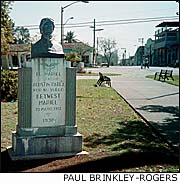
In May 20, 1919 Parlá inaugurates with Johnny Green the first commercial
flight of Cuba. Days later, on May 29, Parlá performs the first commercial
flight to United States with the "Sunshine", first avion property of the Cuban
State. In October of 1919 is constituted the first Cuban aviacion enterprise,
the Compañía
Aérea de Cuba (C.A.C) (Air Company of Cuba), founded
by the rich, and enthusiastic of the aviation and Cuban businessman, Aníbal
J. De Mesa, who employment Agustin Parla as General Manager. Few weeks later Parlá
resigns. May 7, 1920 flies upon Havana during the night, being the first nocturnal
flight. Being able to do career flying, he does not participate more in aeronautical
events. Parla represents Cuba in the air competitions of Miami in 1935 and speaks
in name of the Cuban Senate in recognition to the American Secretary of State,
for the organization of the flight of good will Miami-Havana of 1936. The Secretary
of State R. Malton does it a recognition by its flight of 23 years ago. In 1936
Parla is General Inspecting of the airports of Cuba, inaugurating new airports,
as the Santa Fe airport in Island of Pines in February 24, 1940. He was accepted
like member of the "EB" in 1935. Parla dies in Havana July 31, 1946.
A bust dedicated to Parlá was inaugurated in the airport Key West International July 4, 1957, commemorating the first flight Key West -Cuba. In 1990 the Hispanic of the Florida try to renamed the Key West airport with its name, but fruitlessly. Its name today is preservated in Cuba, and in US in the Smithsonian Institute as one of the "Early Birds", and in the Museum San Carlos, Key West.
![]() Rafael Del Pino Diaz
Rafael Del Pino Diaz
Brigade
General. Veteran of Bay of Pigs and Angola, in 1987 flee to USA
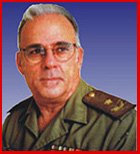 He
was born on September 22 of 1938 in Pinar del Río. After the coup d'etat
of Batista he participates in some protest, and is arrested. To avoiding greater
problems, the family sends it to US to study. In 1956 del Pino returned to Cuba
and immediately was incorporated to the revolutionary movement "26 of July" of
Fidel Castro, by which was imprisoned, and leaves Cuba to Venezuela. In Caracas
participates in acts against the dictator Perez Jiménez, is arrested, but
little later are in liberty when the Venezuelan dictator falling. Travels to Cuba
secretly and joined the guerrillas until the revolutionary triumph. Finishes the
War with the degree of First Lieutenant and is assigned to the Revolutionary Air
Force. He began the flight training in 1959. In March of 1961 had his baptism
of fire as fighter pilot when shoot upon down an airplane AT-11 infractor of the
Cuban air space. Little later, in April of 1961 fought against the disembarking
by Bay of Pigs. In the three days does 10 combat flights in its
T-33, shoot down two B-26 of the invaders. Is declared "Girón Beach Hero"
with the others pilot and is ascended.
He
was born on September 22 of 1938 in Pinar del Río. After the coup d'etat
of Batista he participates in some protest, and is arrested. To avoiding greater
problems, the family sends it to US to study. In 1956 del Pino returned to Cuba
and immediately was incorporated to the revolutionary movement "26 of July" of
Fidel Castro, by which was imprisoned, and leaves Cuba to Venezuela. In Caracas
participates in acts against the dictator Perez Jiménez, is arrested, but
little later are in liberty when the Venezuelan dictator falling. Travels to Cuba
secretly and joined the guerrillas until the revolutionary triumph. Finishes the
War with the degree of First Lieutenant and is assigned to the Revolutionary Air
Force. He began the flight training in 1959. In March of 1961 had his baptism
of fire as fighter pilot when shoot upon down an airplane AT-11 infractor of the
Cuban air space. Little later, in April of 1961 fought against the disembarking
by Bay of Pigs. In the three days does 10 combat flights in its
T-33, shoot down two B-26 of the invaders. Is declared "Girón Beach Hero"
with the others pilot and is ascended. It is one of the first pilots chosen to assimilate the MiG-15 in August of 1961, being one of the three leaders of Escuadrilla of the first MiG-15bis Squadron. During the Cuban Missiles Crisis of October of 1962, was aviation advisor of Fidel Castro. In 1963 he passes to be leader of the Holguín air base. Was send to the Soviet Union to perfect his abilities in the Soviet combat fighters, and in 1965 he is graduated of the Hight War Academy of the Soviet Air Force 'Yury Gagarin'. In 1966 he is General Director of Cubana and then deputy Leader of the DAAFAR. In 1969 he travels to Florida to return the MiG-17 that deserted to US, and in 1972 shaw in flight the MiG-21 to different Latin-Americans military delegations, in task of promotion of the Russian equipment.
When beginning the Cuban participation in the Angolan
War in November of 1975, the Colonel del Pino is designed as leader of the Cuban
Air Force in the conflict. He had the orders of not fighting until expecting express
order of Havana, but he decides to attack in his MiG-21
the enemy that surrounded a Cuban reconnaissance patrol led by Lieutenant
Artemio Cruza. By this initiative violating the order, he is relieve as leader
of the FAR in Angola, and designated Carreras
as his replacement. In March of 1976 destroys in his MiG-21MF an transport airplane
Fokker F27 of the guerrilla.
Days later he remains without fuel and lands his MiG-21 in the same natal village
of the guerrilla leader Jonas Savimbi. In 1977 he is replaced and travels to the
Soviet Union to new courses. This same year he directs the Operation Pico
against the Dominican Republic.
When arriving the MiG-23 to Cuba, del Pino was the Squadron Leader that shows them by first time to the public in the parade of January 2 de1979. He was ascended to Brigade General in 1983, and occupies the charge of Deputy Leader of the DAAFAR. At the beginning of 1987 he stops flying in combat fighters by his health. On May 28, 1987 he deserts to United States in an Cessna-402 airplane of Aerocaribbean, with its third wife, its small daughter, and the son Ramsés, an MiG-23 ex-pilot. In November of 1996 with Eneido Oliva, second military leader of the 2506 Brigade in Bay of Pigs, founding the "Cuban American Military Counsel" (CAMCO), that unite exiled Cubans ex-military. He publishes the books "Amanecer en Girón" (1982), "Inside Castro' s Bunker" (1989), "Proa a la libertad" (1990). He lives somewhere in the United States.
|
|
|
|
|||






